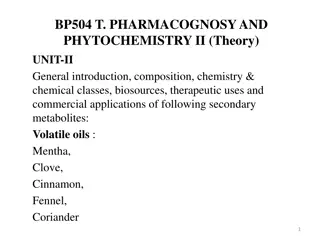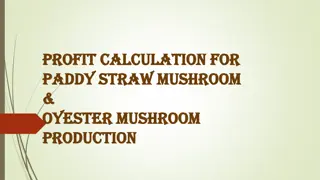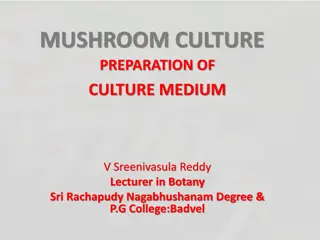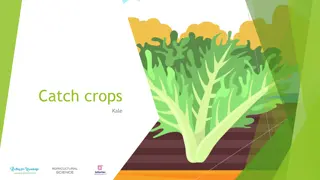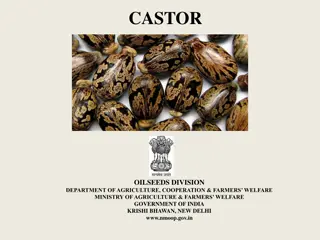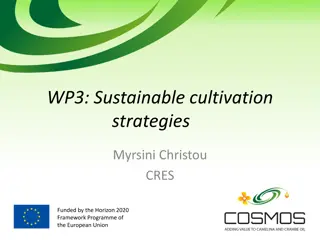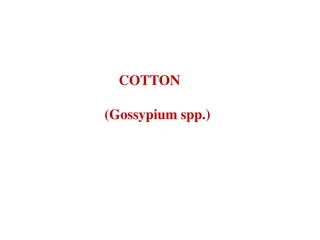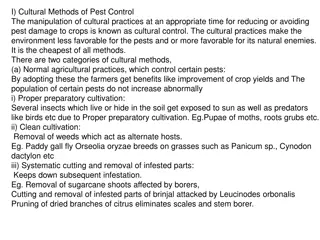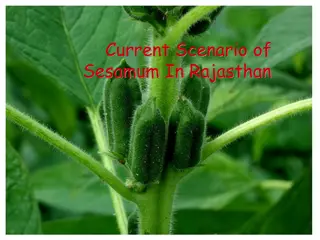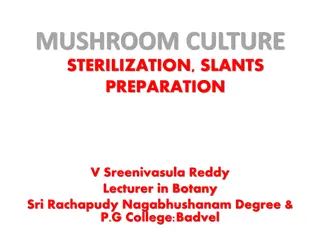Mushroom Cultivation: Importance and Future Prospects
Delve into the world of mushroom cultivation to discover its significance as a nutritious food source, its health benefits, and its potential in enriching human diets globally, particularly in vegetarian populations like in India.
Download Presentation

Please find below an Image/Link to download the presentation.
The content on the website is provided AS IS for your information and personal use only. It may not be sold, licensed, or shared on other websites without obtaining consent from the author.If you encounter any issues during the download, it is possible that the publisher has removed the file from their server.
You are allowed to download the files provided on this website for personal or commercial use, subject to the condition that they are used lawfully. All files are the property of their respective owners.
The content on the website is provided AS IS for your information and personal use only. It may not be sold, licensed, or shared on other websites without obtaining consent from the author.
E N D
Presentation Transcript
StudyMafia.Org Mushroom Cultivation Submitted To: Studymafia.org Studymafia.org Submitted By:
Table Contents Definition Introduction Importance of Mushroom Cultivation Classification of Edible Mushrooms Steps in Mushroom Cultivation Future of Mushroom Cultivation Conclusion 2
Definition The term mushroom means in general a fungus but commonly it is the fruiting body of some fungi which produce and disseminate spores. 3
Introduction Like all other fungi, they lack Chlorophyll and thus cannot produce their own food. They grow saprophytically or sometimes symbiotically upon other dead and living plants respectively to obtain organic matter as food. Mushrooms are variable in size and shape. Many have cap and stalk but some varieties are devoid of stalk. Some varieties even produce fruit bodies below the ground. There are large number of species growing wild in nature, while many are edible, some are highly poisonous. 4
Importance of Mushroom Cultivation Mushrooms are popular for their delicacy and flavour. They are excellent sources of vitamins, proteins and minerals. They are good source of Vitamin B , folic acid, the blood building vitamin, useful in anaemic condition. They also contain pantothenic acid, vitamin B-12, ascorbic acid and the precursor of vitamin A and D. 6
Importance of Mushroom Cultivation They are also good source of phosphorus, potassium, and iron, copper, contain all essential amino acids particularly L-lysine and L-tryptophan. Mushrooms contain least quantity of carbohydrates as well as fats, hence very valuable diet for those suffering from diabetes and heart problems. They also contain compounds capable of preventing heart attack, diabetes, and cancer, infections due to bacteria, fungi, viruses and protozoa. 7
Importance of Mushroom Cultivation Edible mushrooms have been recommended by the FAO as food, contributing to the protein nutrition of the developing countries depends largely on cereals. Mushrooms are useful in treating many human ailments. With increasing population, food demand problems in developing and under developed countries, mushrooms can play an important role to enrich human diet particularly in India where a large section of the population are vegetarians. 8
Importance of Mushroom Cultivation It is an ideal means of recycling agro-wastes which are available abundantly. The spent compost from mushroom farms is a good organic manure and a better substrate for bio-gas production. It is a labour intensive indoor activity which, help the landless, small and marginal farmers to raise their income, diverse economic activity, can create gainful employment, especially for the unemployed/underemployed youth, weaker sections of the society and women. 9
Importance of Mushroom Cultivation Our country has resources, potential for large scale production of mushrooms both for domestic consumption and export. These are cultivated all over the world. Though mushroom cultivation is known from time immemorial its cultivation in India started in 1943 when Volvariella voilvacea was cultivated at Coimbatore, Agaricus bisporus and Pleurorus sojar caju were cultivated in 1966 and 1970 respectively. 10
Importance of Mushroom Cultivation In spite of it, mushroom cultivation in India is only 0.09% of world production. However, Indian Govt., has recognized the importance of mushrooms under changed conditions and established a national research centre at Solan, Himachal Pradesh where an intensive research have been carried out on different aspects of mushrooms, their cultivation to motivate people of India for the use of mushroom as a part of their diet. 11
Classification of Edible Mushrooms Edible mushrooms are classified according to taxonomic position as well as their natural habitat. The taxonomy of mushrooms is a fascinating field, both morphological characters of fruit body, spore production and spore color proved to be useful. The spore print which can be obtained by placing cut fruit body on white paper are covered with a beljar for overnight. 12
Classification of Edible Mushrooms 13
Classification of Edible Mushrooms 14
Steps in Mushroom Cultivation (i) Pure Culture: Mushroom cultivation is carried out in the following manner. The selection of quality mushroom is an important aspect. It must have good quality in respect of growth conditions, taste, aroma, fruiting characters, disease and pests resistant along with long preservation quality (ii) Spawn Production: Good spawn production from monosporeculture is one of the methods of production. It should be fresh, fast growing, free from insects, moulds and mites. 15
Steps in Mushroom Cultivation (iii) Preparation of Substrate/Beds: Preparation of bed is another event. Substrate preparation varies with the mushroom. Either short term period or long term period of substrate preparation can be adapted. Finally it should be decomposed and support the growth of mushroom as well. (iv) Spawning and Spawn Running: Healthy spawn should be spread on the bed in any one of the methods of spawning and allowed to grow. Sufficient moisture has to be maintained. 16
Steps in Mushroom Cultivation (v) Cropping: Once budding appears, one should be ready to harvest. The bud grows to full fledge mushroom and just bloomed should be harvested. Care should be taken not to break mushroom mycelium. (vi) Canning: Mushrooms as far as possible are to be consumed freshly. If needed, they may be stored for a few days after canning as detailed in latter part. 17
Steps in Mushroom Cultivation (v) Canning of Mushrooms: Mushrooms have a good taste when cooked fresh. However, canning is required when consumers are located in far off places. Following steps are involved in canning process or procedure: 1. Pre-Cleaning Mushrooms are cleaned to remove foreign particles, soil etc. 2. Washing Mushrooms are washed in water. 18
Steps in Mushroom Cultivation 3. Blanching Mushrooms are blanched in hot water having 0.2% citric acid for 3-5 minutes. This process results in loss of 30% weight. 4. Cooling Blanched mushrooms are cooled through continuous counter flow cooling system. 5. Grading Mushrooms are graded according to size. 6. Slicing Mushrooms are sliced for the required size. 7. Filling The cans are filled and weighed. 19
Steps in Mushroom Cultivation 8. Brining and Exhausting Hot brine solution (salt 2%+sugar 2%+citric acid 0.3%) is added and temperature is raised to 80 C in the centre of can to exhaust. 9. Can Sealing Cans are sealed with lid. 10. Retorting The sealed cans are sterilized at 15 PSI for 15-20 minutes. 11. Labelling and Packing The cans are labeled and packed in cartons. Different sizes of cans are used as per requirements. 20
Nutritional Aspects of Mushrooms: Mushrooms, rich in nutrients, are being used as nutraceuticals. They are considered to provide strength to warriors in battles as believed by Greeks, while Chinese feel that they are health food and treat them as elixir of life. Romans consider them as God given food, while pharha, European tribes, considers them as food of delicacy. 21
Nutritional Aspects of Mushrooms: Mexican Indians eat them during festive occasion as hallucinogens. They are food of fibrous nature, low in fat, rich in proteins, vitamins, this food preferred for diabetes and heart patients. Similarly mushrooms are rich in all essential vitamins and contains full complement of mineral composition 22
Future of Mushroom Cultivation: Increasing awareness of nutritive and medicinal value of mushroom, a boost in cultivation of mushrooms resulted in mass scale. Cultivation of mushrooms helps to convert agro- wastes into human food. Their cultivation provides labour employment as they are fast growing and are responsible for production of quality food. Mushrooms represent untapped source of nutraceuticals and valuable palatable food. 23
Future of Mushroom Cultivation: Substrate/compost preparation with special reference to fermentation, collection of strains of mushrooms from different geographical regions and their evaluation use in breeding work. Breeding for high yielding strains of species will be of immense value of Agarics, Pleurotus, other promising mushroom for both cold and hot climate is of an urgent need. Improvements in prolongation of shelf life and canning and processing will also boost the prospects of mushroom cultivation. 24
Conclusion Mushroom cultivation is perhaps the most important microbial technology, after the yeast fermentation, in the economic terms. It promises to supply food with good quality protein produced from worthless lignocellulosic wastes of varied origins. In future, newer mushrooms are likely to be added to diversify the portfolio of the cultivated mushrooms and the production of the presently consumed mushrooms will increase with the genetic improvement of the strains and the advancements in the cultivation technology. 25
References Google.com Wikipedia.org Studymafia.org Slidespanda.com
Thanks To StudyMafia.org


